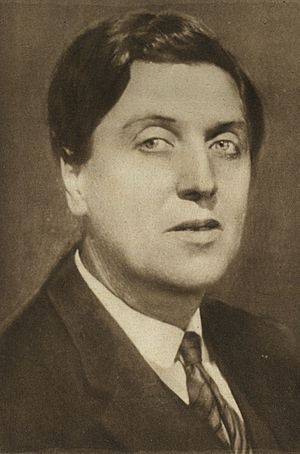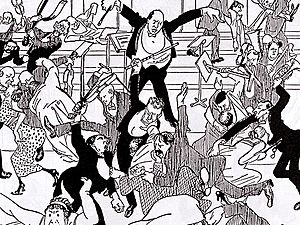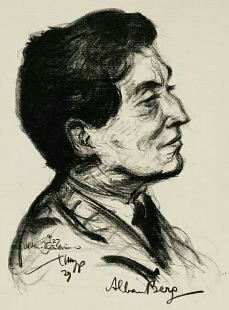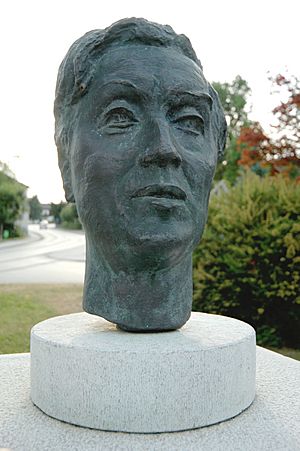Alban Berg facts for kids
Quick facts for kids
Alban Berg
|
|
|---|---|

Berg c. 1930 (by Max Fenichel)
|
|
| Born |
Alban Maria Johannes Berg
9 February 1885 Vienna, Austria
|
| Died | 24 December 1935 (aged 50) |
| Resting place | Hietzing Cemetery Vienna, Austria |
| Occupation | Composer |
| Spouse(s) |
Helene Nahowski
(m. 1911) |
Alban Berg (born 9 February 1885 – died 24 December 1935) was an Austrian composer. He was part of a group called the Second Viennese School. His music mixed the emotional style of Romantic pieces with a newer system called the twelve-tone technique. Even though he didn't write a huge number of works, he is seen as one of the most important composers of the 20th century. People remember his music for being very expressive and full of feeling.
Berg was born and lived in Vienna, Austria. He only started composing when he was fifteen years old. He learned about music theory and how to compose from Arnold Schoenberg between 1904 and 1911. From Schoenberg, he learned important ideas like the twelve-tone technique. Some of Berg's most famous works include his operas Wozzeck (finished in 1924) and Lulu (finished after he died in 1935). He also wrote chamber music like the Lyric Suite and a Violin Concerto. Many people felt his music brought more "human values" to the twelve-tone system, making it sound more "emotional" than Schoenberg's.
Berg died in 1935 from an infection.
Contents
Life and Career
Early Life
Alban Berg was born in Vienna. He was the third of four children. His father had a successful business. The family faced money problems after his father died in 1900. This made things harder for young Berg. He was more interested in reading than music when he was a child. He only started teaching himself music at age fifteen.
Berg didn't have much formal music training at first. But in October 1904, he became a student of Arnold Schoenberg. He studied counterpoint, music theory, and harmony with Schoenberg. By 1906, he was studying music full-time. In 1907, he began lessons specifically for composing. His early student pieces included five ideas for piano sonatas. He also wrote songs, like his Seven Early Songs. Three of these songs were the first of his works to be played in public.
His early ideas for piano music led to his Piano Sonata, Op. 1 (1907–1908). This piece is considered a very strong "first" work for a composer. Berg studied with Schoenberg for six years, until 1911. Schoenberg taught him that a musical piece should be unified. This meant all parts should come from one main idea. This idea was later called developing variation. Berg passed this on to his own students. The Piano Sonata is a good example of this idea. The whole piece comes from its opening musical idea.
New Ideas in Music
Berg was part of a group of important artists and thinkers in Vienna. This was during a time known as the fin de siècle, which means "end of the century." His friends included other musicians, painters, writers, and architects.
In 1906, Berg met a singer named Helene Nahowski. She came from a rich family. Despite her family's disapproval, Alban and Helene got married on 3 May 1911.
In 1913, two of Berg's Altenberg Lieder (songs) were played for the first time in Vienna. Schoenberg conducted the concert, which became famous as the Skandalkonzert (Scandal Concert). These songs were based on short poems and used a very large orchestra. The performance caused a riot, and the concert had to be stopped. After this, Berg mostly kept the work private. It wasn't played completely until 1952.
From 1915 to 1918, Berg served in the Austro-Hungarian Army during World War I. During a break in 1917, he worked faster on his first opera, Wozzeck. After the war, he moved back to Vienna. There, he taught music to private students. He also helped Schoenberg with his Society for Private Musical Performances. This group wanted to create a perfect place to explore and enjoy new music. They did this by having open rehearsals and repeat performances. They also kept professional music critics away.
Success of Wozzeck and Lulu (1924–29)
In 1924, three parts from Wozzeck were performed. This brought Berg his first public success. Berg finished the opera in 1922. It was first performed completely on 14 December 1925 in Berlin. Today, Wozzeck is seen as one of the most important operas of the 20th century. Berg started his second opera, Lulu, in 1928. But he stopped working on it in 1929 to write a concert song called Der Wein. This song helped him prepare for Lulu in many ways.
Other well-known pieces by Berg include the Lyric Suite (1926). This piece later showed hidden messages about a secret love story. He also wrote Three Pieces for Orchestra (finished in 1915). Another important work is the Chamber Concerto (1923–25). This piece is for violin, piano, and 13 wind instruments. It is very carefully written.
Final Years (1930–35)
Life for musicians became very hard in the 1930s. This was because of the rise of Nazi ideas in Germany and Austria. These ideas were against modern art and music. If a composer was connected to someone Jewish, their music could be banned. Berg had studied with Arnold Schoenberg, who was Jewish. Because of this, it became harder for Berg's music to be performed in Germany. Eventually, his music was banned and called "degenerate music."
In 1932, Berg and his wife bought a quiet house in the countryside. It was called the Waldhaus near Schiefling am See. Here, he could work in peace, mainly on Lulu and the Violin Concerto.
Many performances of his work in Germany were cancelled by the Nazis. The first performance of Lulu was supposed to be in Berlin. But the authorities there rejected it in 1934. Even in Vienna, there were fewer chances for modern musicians to perform.
Berg stopped working on Lulu to write his Violin Concerto (1935). He needed the money from this project. He wrote this sad and beautiful piece very quickly. It was played for the first time after he died. This concerto has become Berg's most famous and loved work. Like many of his later pieces, it uses Schoenberg's twelve-tone technique in a special way. This allowed Berg to include parts that sounded like older, more traditional music. For example, it includes parts of a Bach song and a folk song. The Violin Concerto was dedicated "to the memory of an Angel." This angel was Manon Gropius, the daughter of architect Walter Gropius and Alma Mahler, who had died young.
Death
Berg died at age 50 in Vienna. It was on Christmas Eve, 1935. He died from blood poisoning. This was likely caused by an infection from an insect sting he got in November. He was buried at the Hietzing Cemetery in Vienna.
Before he died, Berg had only finished writing the music for the first two acts of Lulu. The completed acts were first performed in Zürich in 1937. For a long time, his wife Helene did not allow anyone to finish the last act. But Berg had actually finished the main ideas for it. So, a composer named Friedrich Cerha secretly wrote the full music for the last act. It was finally performed in Paris in 1979, soon after Helene Berg died.
Legacy
Alban Berg is remembered as one of the most important composers of the 20th century. His operas are performed more often than those of other composers from the Second Viennese School. People say he brought more "human feelings" to the twelve-tone system. His works are seen as more "emotional" than Schoenberg's. Many believe he helped keep the traditional Viennese style alive in his music.
A group called the Alban Berg Quartett (a string quartet) was named after him. They played music from 1971 to 2008.
An asteroid, 4528 Berg, was named after him in 1983.
The Alban Berg Monument was put up next to the Vienna State Opera in 2016.
Major Compositions
Piano
- Piano Sonata, Op. 1
Chamber Music
- String Quartet, Op. 3
- Four Pieces for Clarinet and Piano, Op. 5
- Lyric Suite, string quartet
- Chamber Concerto (1925) for piano, violin and 13 wind instruments
Orchestral Music
- Three Pieces for Orchestra, Op. 6
- Violin Concerto
Vocal Music
- Seven Early Songs
- Vier Lieder (Four Songs), Op. 2
- Five Orchestral Songs on Postcard Texts of Peter Altenberg, Op. 4
- Der Wein
- Schliesse mir die Augen beide
Operas
- Wozzeck, Op. 7 (1925)
- Lulu (1937)
See Also
 In Spanish: Alban Berg para niños
In Spanish: Alban Berg para niños




